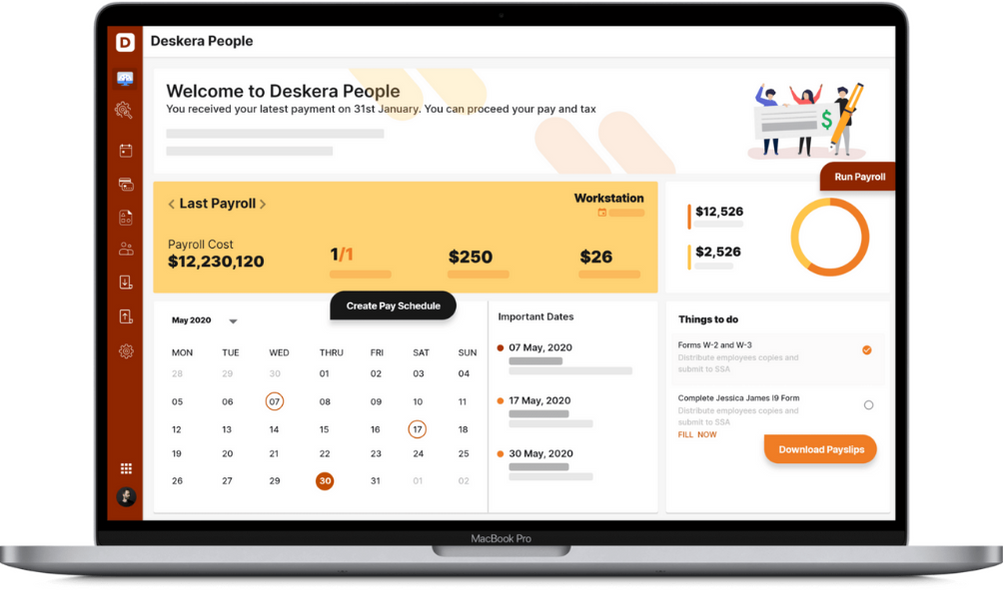Employers use 1099s and W-2s to record earnings and deductions for various workers. 1099 employees are frequently referred to as self-employed workers or freelancers. Employees are sometimes referred to as W-2 workers.
The US Bureau of Labor Statistics reports that there are 9.548 million self-employed workers. As a result, many employers will need to hire contractual or self-employed employees at some point.
This makes it essential for them to understand the difference between 1099 vs. W-2 form. In this article, we will learn about form 1099, form W-2, the difference between 1099 vs. W-2, and much more.
Here are the points covered in this article:
- Why should you understand the difference?
- How to determine if a worker receives a Form W-2 or 1099
- What is a 1099 worker?
- Pros and Cons of hiring 1099 workers
- What is a W-2 worker?
- Pros and Cons of hiring W-2 workers
- Can a worker be both a 1099 and a W-2?
Let’s Start!
Why should you understand the difference?
For several reasons, it's critical to understand the distinction between 1099 vs. W-2 employees:
- First, misclassifying a worker as self-employed might cause IRS fines or an employee misclassification lawsuit filed against your company.
- Second, employee classifications impact how you and your employees are taxed. You must withhold income taxes and pay taxes on earnings paid to W-2 workers. You do not require withholding or paying taxes on payments made to 1099 contractors.
- Third, employee categories govern how much authority you have over a worker's schedule, compensation, and other aspects of their employment. When, how, and where they work are all determined by independent contractors. Employees follow your regulations and work according to your timetable.
Every small company owner should know the distinctions between these classifications and when to recruit a W-2 vs. a 1099 employee. However, the distinctions are not always obvious. If you're still unsure about the specifics, you're not alone. So let's take a deeper look at each category.
But how can you determine whether an employee is under the 1099 vs. W-2 form? Let’s see!
How to determine if a worker receives a Form W-2 or 1099
To determine if a worker should receive a Form W-2 vs. 1099, answer the following questions:
- Does the firm have control over or have the authority to govern what the employee does and how they conduct their job?
- Does the firm or payer control the business aspects, such as how the employee is paid? Are the employee's expenses covered? Who provides the tools and supplies for the job?
- Do you have employee policies or provide employee-type benefits such as pensions, insurance, and vacation pay? Is the job produced critical to the success of the company? Will the partnership last when the task is completed?
As a business owner, it is your responsibility to examine the elements above when assessing whether a worker is an employee or an independent contractor. It's also worth noting that each state has its own set of rules and regulations regarding labour categories. Unfortunately, no single element can make that call.
Some of your responses to the preceding questions may suggest that the worker is an employee. Others may suggest that the employee is a 1099 contractor. It is your responsibility to consider all options, assess your level of influence over the employee, and properly document your final decision.
Next, let's look at what 1099 employees are and the pros and cons of hiring them.
What are 1099 employees?
A self-employed worker or freelancer is a 1099 employee. Contract workers and gig workers are examples of 1099 workers. Businesses often engage these personnel to execute a specific task or work on a particular project specified in a signed contract.
1099 employees decide when, how, and where they work. They choose the tools and procedures that will perform the task. They can even engage their workers to assist them in completing the task.
1099 workers may serve multiple clients at the same time. These employees are classified as "self-employed," which means they pay their taxes and offer their benefits as self-employed.
You are not required to withhold or submit payroll taxes on their behalf, nor are you required to provide them with the same benefits that you do.
The Pros and Cons of 1099 Workers
It all comes down to your business objectives and goals when deciding whether to engage a 1099 contractor.
For example, a contractor may be an excellent match if you only need one or two specialized projects handled. On the other hand, if your company's demands are more constant, a W-2 employee may be the best option. Hiring 1099 labour has both advantages and downsides, as is typically the case.
Now, you've some basic knowledge about 1099 employees. Let’s now look at the employees covered in the W-2 form.
What exactly is a W-2 employee?
A W-2 employee works for your company. These workers might work full-time or part-time. Employees follow your timetable and company policies. They use employee advantages such as medical insurance, holiday pay, and overtime pay. They are also provided with at least the minimum wage.
For W-2 employees, you must collect Social Security and Medicare taxes and pay payroll taxes. In addition, your responsibility is to supply your staff with the equipment and resources they require to complete their tasks. Any person who cannot be classified as a 1099 freelancer is classified as a W-2 employee by default.
The Pros and Cons of W-2 employees
In this case, you have more control over their work and receive continuing help. However, such advantages come at a cost. You need to consider your company's needs while deciding whether to hire W-2 employees or not.
Can a worker be both a 1099 and a W-2?
According to the IRS, Yes. There may be times when a person works as both a freelancer and an employee for the same company. Workers might be on-call for both in the same calendar year, either concurrently or at different periods.
It is important to note that submitting a 1099 and a W-2 for the same employee may trigger a tax audit. If the IRS suspects an employee has been misclassified, it will conduct such audits on employers.
And that's everything you need to know about 1099 vs. W-2 employees. Now let's look at some of the most frequently asked questions about 1099 vs. W-2 employees.
Frequently Asked Questions
What are the tax differences for 1099 vs. W-2 employees?
Your tax liabilities differ depending on whether you are a 1099 contractor or a W-2 employee. You are not required to withhold or pay taxes on 1099 contractors as a business owner. These employees handle their taxes and benefits.
W-2 employees are paid regularly and have access to employee benefits. As a business owner, it is your job to withhold taxes from their paychecks and submit those taxes to the IRS on a W-2 form.
Is a 1099 or W-2 employee a better match for your company?
There is no correct or incorrect response. The demands of your company determine the sort of employee you recruit. For example, an independent contractor may be the best option if you're working on a temporary or short-term project. However, if you want temporary help during the hectic Christmas season, a seasonal W-2 employee is the better option.
What specific limitations or requirements apply to those who submit W-2 or 1099 information in bulk to the IRS?
None. Whether the data is supplied directly by the employer or by a third party, the reporting requirements, data formats, and methods are the same.
How Can Deskera Assist You?
As a business, you must be diligent with employee leave management. Deskera People allows you to conveniently manage leave, attendance, payroll, and other expenses. Generating payslips for your employees is now easy as the platform also digitizes and automates HR processes.

Key Takeaways
- It is critical to understand the distinction between 1099 vs. W-2 employees, as misclassifying them can incur fines from the IRS and mispayment of salaries and income tax.
- To determine if a worker should receive a Form W-2 vs. 1099, answer the following questions:
- Who controls the working of the employees?
- Does the company or payer control the pay of the worker?
- What type of relationship does the company have with the employee?
- A self-employed worker or independent contractor is a 1099 employee. Freelancers and gig workers are examples of 1099 workers.
- A W-2 employee works for your company. These workers might work full-time or part-time. Employees follow your timetable and company policies.
- According to the IRS, there may be times when a person works as both a self-employed and an employee for the same company
Related Articles











